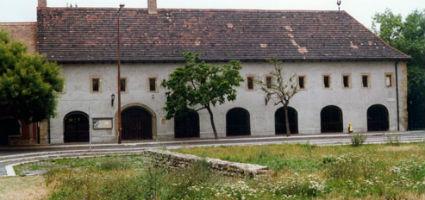2024. April 20. Saturday
Budapest Gallery Exhibition Hall - Budapest
 |
Address: 1036, Budapest Lajos u. 158.
Phone number: (1) 388-6784
E-mail: info@budapestgaleria.hu
Opening hours: Tue-Sun 10-18
|
The exhibition has closed for visitors.
2021.07.30. - 2021.10.03.
Budapest Gallery’s next international group exhibition borrows its title from the domain of natural sciences. Microtomy stands for the method of slicing extremely thin sections of nanoscale thickness from a material – whether mineral, animal, plant or human – to be examined under a microscope.
The painters represented at the exhibition Microtomy engage in a similar analysis with a focus on the nature of the material. Dissecting painting as a medium into its basic components, they create artworks that subvert the triad of stretcher-canvas-paint. They split the stretcher, slash and sew up the canvas, dissolve or scrape back pigment from the image surface. They reveal traces of the technique of masking, they press paint through the threads of the fabric, or leaving the canvas behind, they paint straight on the wall. While Dániel Bernáth and Dejan Dukic are interested in the organic quality of painting as they engender their works in immediate physical contact with the material, with the help of natural forms, Attila Bagi and Rita Koszorús are both intrigued by the relation of paintings to space and the act of revealing the superimposed layering of image surfaces as they evolve during the creative process. Although each of the four young artists conducts his or her “material experiments” from different approaches and for different reasons, still, all of their works can be interpreted as reactions to new abstract painting, while also querying the current appraisal and raison d’être of painting as an art form.
The painters represented at the exhibition Microtomy engage in a similar analysis with a focus on the nature of the material. Dissecting painting as a medium into its basic components, they create artworks that subvert the triad of stretcher-canvas-paint. They split the stretcher, slash and sew up the canvas, dissolve or scrape back pigment from the image surface. They reveal traces of the technique of masking, they press paint through the threads of the fabric, or leaving the canvas behind, they paint straight on the wall. While Dániel Bernáth and Dejan Dukic are interested in the organic quality of painting as they engender their works in immediate physical contact with the material, with the help of natural forms, Attila Bagi and Rita Koszorús are both intrigued by the relation of paintings to space and the act of revealing the superimposed layering of image surfaces as they evolve during the creative process. Although each of the four young artists conducts his or her “material experiments” from different approaches and for different reasons, still, all of their works can be interpreted as reactions to new abstract painting, while also querying the current appraisal and raison d’être of painting as an art form.